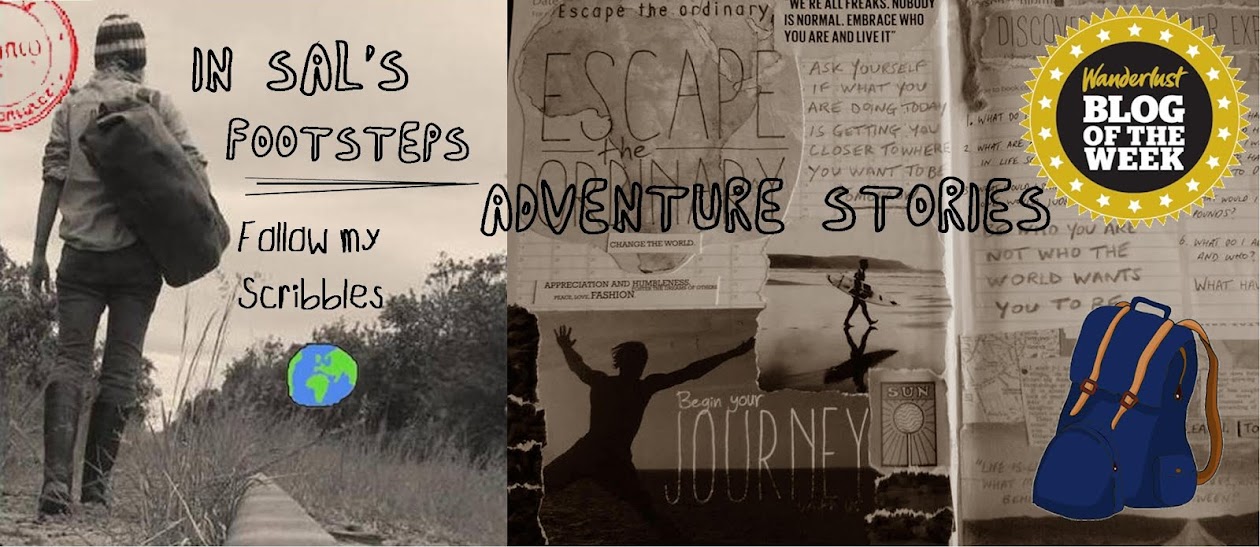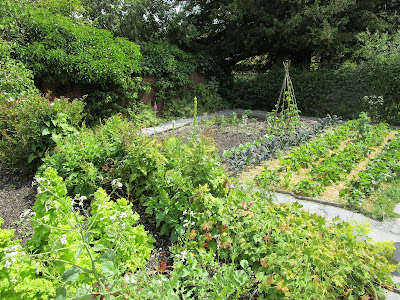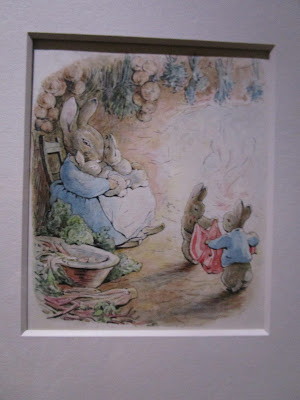Thanks for dropping by again for my next blog from the Lake District. If you'd read my last blog where I slogged my way up and down 7 mountains over 24km in one day, this is a little less intense post this time round. The weather in the Lake District over a week has been very changeable this summer, one day its fine and sunshine and the next you're soaked by shifting thunderstorms!
By the local Kendalians (I think that's right) this is normal and its pot luck what weather you get even in mid summer!
So on a dry day I was up and about early to make the most of the daylight hours and get back into the great outdoors for another day of adventure and some long distance walking following in the footsteps of the Lake District's most world famous resident Beatrix Potter, who lived here in the South lakes once upon a time ago where she wrote a number of her famous children's stories inspired by the natural beauty of the pastoral scenery at her home 'Hilltop' in the village of Near Sawrey.
When Beatrix Potter died in 1943, she had already agreed with the National Trust she would have her home left as it was and turned into a world heritage site for people to come visit her home from all over the world, her stories are as wonderful as she was! So 76 years later, I'm accepting the invitation and dropping in to see where all our favourite childhood stories came to life.
Lake Windermere - with dancing geese!
But first, I had to get across the famous Lake Windermere, the largest fresh water lake in England at 10 miles long and 1 mile wide (that's a big lake when you think about it!). Arriving at Windermere town by the cool network of buses across the National Park and walking the 1 mile down to the marina at Bowness-on-Windermere, I wasn't going to take a kayak but pay the £3.20 foot passenger boat fee to cross the lake on a shortcut without going around the head of it on a bus. The lake is swarming with tourists and the marina boasts a number of cruises to take you up and down the lake and to various points of interest on the lakeside over the long summer days.
The boat would get me across the heart of the lake and to Ferry House where you can pay for a tour bus ride to Hill Top farmhouse or walk 2 miles to the village of Near Sawry.
Of course, I'm going to walk there - this is an adventure right?
Great boat guard dog!
Video as I begin my journey to Near Sawrey from Lake Windermere
So I'm armed with a borrowed Ordnance Survey map and ready to take on the challenge of getting myself across the 2 miles of Cumbrian countryside to the village. Shouldn't be too hard...
Walking route to Beatrix Potters House
I walk a while, intently trying to follow my ripped OS map amd muster up some sense in it when....
Ha! So much for a map! Its sign posted the whole way! No excuse of not getting there.
Snapshots following the trail to Near Sawry and Hill Top....
Getting close, just in the next village....
Almost there, just through the fields....
and upsetting the landowners sheep.....
Made it! Behold the little village of Near Sawry and the home of Beatrix Potter!
Hill Top and Beatrix Potter
Wahooh! made it to Hilltop.
Beatrix Potter's real name was actually Helen Beatrix, a lonely London girl from a rich Victorian family in South Kensington. She wasn't just a children's author but an artist and keen conservationist, forging a strong relationship with the British National Trust. She wrote The Tale of Peter Rabbit in the late 1800's before moving to the Lake District which would you believe got rejected by publishers, so she self published hundreds of copies for friends and family and was convinced that her sweet and moral stories using animals from the British wildlife had a audience and would be of huge appeal to adults and children alike. Of course, she was right.
Eventually a publisher Frederick Warne & Co saw the potential interest and sales of her stories and took them on with the condition she would do the colour illustrations herself - you see J.K Rowling and Beatrix Potter were both turned down by publishers at first!
As you wander through Near Sawry, you can see how much of a huge imagination Beatrix Potter had and the inspiration she took from her surroundings and life of the village, putting them into her stories and the characters - the red post box is in a Peter Rabbit story and the white picket fence is Tom Kitten's Gate.
Photo of Beatrix Potter in the doorway of Hill Top, a 17th-century working victorian farmhouse which she bought in 1905 after visiting the Lake District many times on childhood holidays. By 1905, Beatrix Potter had already written four best-selling children's books and bought Hilltop in Near Sawrey to help recover from the heartbreak of the death of her fiance.
The house itself was on a working farm and once she bought it, Beatrix Potter had an extension built to the original farmhouse so the resident farmer could live with his family and teach her more about gardening and farming which was a growing interest of hers and led to her significant part of conserving the Lake District with the National Trust.
The house itself was on a working farm and once she bought it, Beatrix Potter had an extension built to the original farmhouse so the resident farmer could live with his family and teach her more about gardening and farming which was a growing interest of hers and led to her significant part of conserving the Lake District with the National Trust.
It was also a retreat for her to collect inspiration from the house and the surrounding pastoral scenery to write three of her books - The Tale of Samuel Whiskers, Jemima Puddle-Duck and Tom Kitten.
You can see in the watercolour illustrations that Beatrix Potter did for each of her 23 'little white books' that she used Hill Top and the vegetable garden on the property to inspire the scenery settings for the characters...and sold the books only for a shilling (12p) so Victorian children could afford them.
Don't want to show you too much of the inside the house so I'll show you some of the best bits....
This is the Entrance Hall to Hill Top which features in quite a few scenes of her story books, Beatrix Potter would intentionally buy or acquire farmlike objects to adorn her house along with artwork of the Lake District painted by her dad and brother. Some of the paintings are so big that they take up the four corners of the walls!
Beatrix Potters hat and shoes, no really, they are her hat and shoes!
This clock is pretty interesting and was very special to Beatrix Potter, a clock gifted by her grandfather that matches the lunar calendar- you see the moon face? it moves according to the face of the moon in the year.
What a talent!
Beatrix Potter showed a precocious talent for art since she was a child, visiting the Natural History Museum in London to sketch the insects, animals and plant life. She would illustrate all her own books in watercolours, but this ceramic print of rabbits was done when she was just 14!
The Hill Top guides are fascinating to listen to (in their friendly Cumbria accents!) and talked about how when building the extension to Hill Top, alot of rats scuttled from the walls as they were disturbed by the construction and a few rat holes are dotted around the foot of the wooden doors of the house - inspiring The Tale of Samuel Whiskers.
Beatrix Potter also loved collecting things over the course of her life and even enjoyed having merchandise of her books in her collection - Peter Rabbit tea set.
Beatrix Potter's bureau where she would have written countless letters and ruminated about her story books at this very desk. In fact, talking about letters, The Tale of Peter Rabbit actually spawned from a letter Beatrix Potter wrote to a sick child when she didn't know what to write to him!
She realised that the Rabbit story would make a good book and tracked down the original letter and copied it and so the famous story of Peter Rabbit...
The vegetable garden at Hill Top also acted as an inspiration for scene setting in her story books, Mr McGregor's Garden and in Jemima Puddle-Duck all featured the garden in her fanciful imagination. Over the course of her lifetime, Beatrix Potter kept over a hundred pets and used the squirrels, hedgehogs, rabbits and other wildlife as characters that conjured up adventures around the farm.
Beatrix Potters humble vegetable garden....with her little white beehive
The paved pathway up into Hill Top in summer as seen in the Tale of Tom Kitten. The National Trust gardeners try to keep the garden and plant species as similar to when she was living here from 1905 to 1943.
So, the rest is for you to explore if you ever find yourself in the Lake District, Hill Top is a nice stop. In fact, Beatrix Potter was also a respected Herdwick sheep breeder and at the time of her death gave 4,000 acres of preserved land she had bought over to the National Trust so generations after her could enjoy the same pleasure the Lake District gave to her over her lifetime. What a great woman.
So after visiting Hill Top, you can travel the 2 miles north to the neighbouring village of Hawkeshead to the Beatrix Potter Gallery
So of course I walked there....I'm the adventurous type!
Found it! Tucked away at the other end of the village is the Gallery, last entry is 3.30 so got there just in time - the building was actually the office of William Heelis who was a local lawyer that Beatrix Potter ended up marrying. Here she would have signed all those contracts to buy Hill Top and her acres of land destined for the National Trust years later...
The gallery houses alot of Beatrix Potters original illustrations which came from her stories based on her own life and encounters during her rural living at Near Sawrey- the most productive time in her illustrating and writing career.
This stuffed bunny toy was the first prototype for Peter Rabbit from Germany and guess what...Beatrix Potter hated it!
One of the original The Tale of Peter Rabbit books Beatrix Potter self-published in 1902 when she was turned down by six publishing houses before Frederick Warne and Co. commercially published it.
This was nice to see, Beatrix Potters watercolour art set that used to belong to her mother, all those beautiful illustrations that came from this set.
Sketches of hedgehogs for The Tale of Miss Tiggy-Winkle, with the original manuscript of the story written in an exercise book. Beatrix Potter based the character on a washer woman she was fond of at her childhood holiday in Scotland and a pet hedgehog named Tiggy.
And some of her collection of favourite illustrations on view....Beatrix Potter herself claimed she was not as good at drawing humans as she was animals and where she'd made mistakes or was unhappy with the illustration, would copy it till she was happy and stick it over the top. (You'd never notice)
Miss Tiggy-Winkle
Tom Kitten
Peter Rabbit
Jemima Puddle-Duck
The Tailor of Gloucester
Hawkeshead village also has their own Peter Rabbit and Friends shop - for everything well....Peter Rabbit and Friends...a super fans dream (and I did meet one of those from Canada!)
So there you have it, I had walked in Beatrix Potters footsteps and I finished the rest of my trip walking the 6 miles back past tarns, uprising fells and through the dank woods of Cumbria to the town on Ambleside - making my walking distance close to 12 miles!
Think that was enough walking for one day!
Thanks for reading about my adventures in the Lake District, do check out my next blog getting back on to my Kilimanjaro training.
Peace


























































No comments:
Post a Comment
Scribble back!